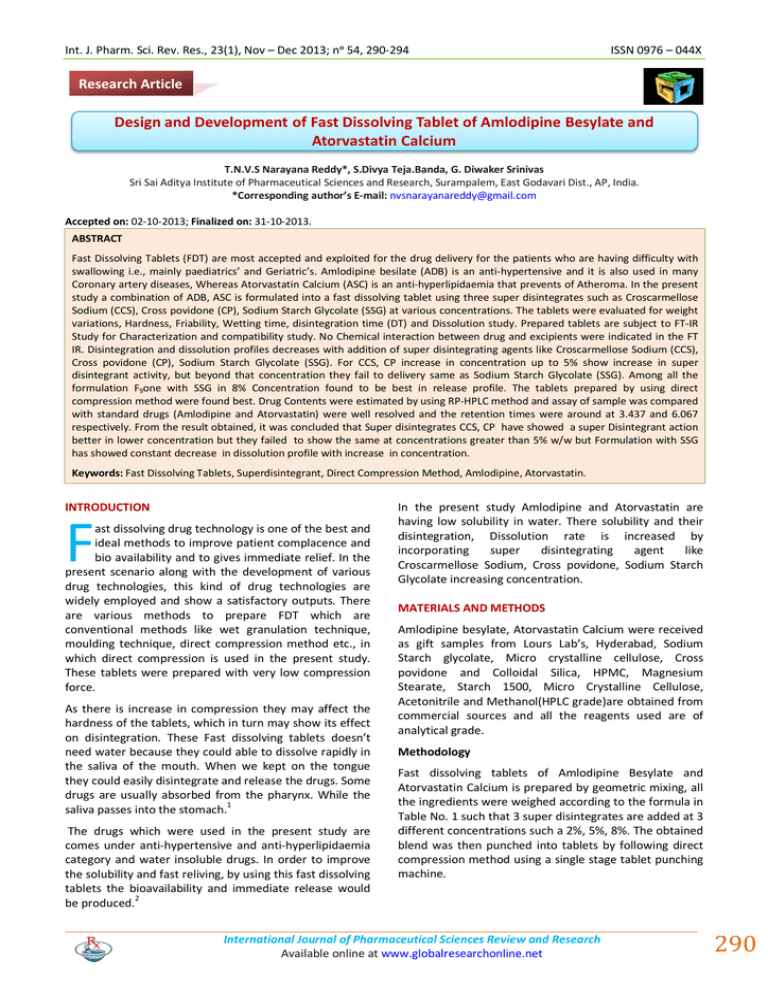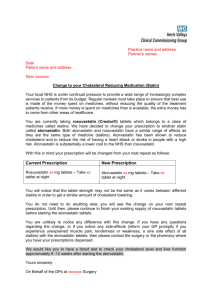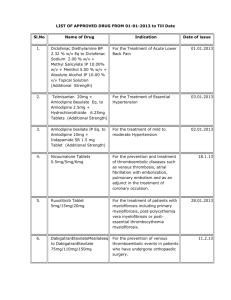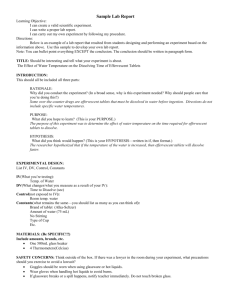Document 13309425
advertisement

Int. J. Pharm. Sci. Rev. Res., 23(1), Nov – Dec 2013; nᵒ 54, 290-294 ISSN 0976 – 044X Research Article Design and Development of Fast Dissolving Tablet of Amlodipine Besylate and Atorvastatin Calcium T.N.V.S Narayana Reddy*, S.Divya Teja.Banda, G. Diwaker Srinivas Sri Sai Aditya Institute of Pharmaceutical Sciences and Research, Surampalem, East Godavari Dist., AP, India. *Corresponding author’s E-mail: nvsnarayanareddy@gmail.com Accepted on: 02-10-2013; Finalized on: 31-10-2013. ABSTRACT Fast Dissolving Tablets (FDT) are most accepted and exploited for the drug delivery for the patients who are having difficulty with swallowing i.e., mainly paediatrics’ and Geriatric’s. Amlodipine besilate (ADB) is an anti-hypertensive and it is also used in many Coronary artery diseases, Whereas Atorvastatin Calcium (ASC) is an anti-hyperlipidaemia that prevents of Atheroma. In the present study a combination of ADB, ASC is formulated into a fast dissolving tablet using three super disintegrates such as Croscarmellose Sodium (CCS), Cross povidone (CP), Sodium Starch Glycolate (SSG) at various concentrations. The tablets were evaluated for weight variations, Hardness, Friability, Wetting time, disintegration time (DT) and Dissolution study. Prepared tablets are subject to FT-IR Study for Characterization and compatibility study. No Chemical interaction between drug and excipients were indicated in the FT IR. Disintegration and dissolution profiles decreases with addition of super disintegrating agents like Croscarmellose Sodium (CCS), Cross povidone (CP), Sodium Starch Glycolate (SSG). For CCS, CP increase in concentration up to 5% show increase in super disintegrant activity, but beyond that concentration they fail to delivery same as Sodium Starch Glycolate (SSG). Among all the formulation F9one with SSG in 8% Concentration found to be best in release profile. The tablets prepared by using direct compression method were found best. Drug Contents were estimated by using RP-HPLC method and assay of sample was compared with standard drugs (Amlodipine and Atorvastatin) were well resolved and the retention times were around at 3.437 and 6.067 respectively. From the result obtained, it was concluded that Super disintegrates CCS, CP have showed a super Disintegrant action better in lower concentration but they failed to show the same at concentrations greater than 5% w/w but Formulation with SSG has showed constant decrease in dissolution profile with increase in concentration. Keywords: Fast Dissolving Tablets, Superdisintegrant, Direct Compression Method, Amlodipine, Atorvastatin. INTRODUCTION F ast dissolving drug technology is one of the best and ideal methods to improve patient complacence and bio availability and to gives immediate relief. In the present scenario along with the development of various drug technologies, this kind of drug technologies are widely employed and show a satisfactory outputs. There are various methods to prepare FDT which are conventional methods like wet granulation technique, moulding technique, direct compression method etc., in which direct compression is used in the present study. These tablets were prepared with very low compression force. As there is increase in compression they may affect the hardness of the tablets, which in turn may show its effect on disintegration. These Fast dissolving tablets doesn’t need water because they could able to dissolve rapidly in the saliva of the mouth. When we kept on the tongue they could easily disintegrate and release the drugs. Some drugs are usually absorbed from the pharynx. While the 1 saliva passes into the stomach. The drugs which were used in the present study are comes under anti-hypertensive and anti-hyperlipidaemia category and water insoluble drugs. In order to improve the solubility and fast reliving, by using this fast dissolving tablets the bioavailability and immediate release would be produced.2 In the present study Amlodipine and Atorvastatin are having low solubility in water. There solubility and their disintegration, Dissolution rate is increased by incorporating super disintegrating agent like Croscarmellose Sodium, Cross povidone, Sodium Starch Glycolate increasing concentration. MATERIALS AND METHODS Amlodipine besylate, Atorvastatin Calcium were received as gift samples from Lours Lab’s, Hyderabad, Sodium Starch glycolate, Micro crystalline cellulose, Cross povidone and Colloidal Silica, HPMC, Magnesium Stearate, Starch 1500, Micro Crystalline Cellulose, Acetonitrile and Methanol(HPLC grade)are obtained from commercial sources and all the reagents used are of analytical grade. Methodology Fast dissolving tablets of Amlodipine Besylate and Atorvastatin Calcium is prepared by geometric mixing, all the ingredients were weighed according to the formula in Table No. 1 such that 3 super disintegrates are added at 3 different concentrations such a 2%, 5%, 8%. The obtained blend was then punched into tablets by following direct compression method using a single stage tablet punching machine. International Journal of Pharmaceutical Sciences Review and Research Available online at www.globalresearchonline.net 290 Int. J. Pharm. Sci. Rev. Res., 23(1), Nov – Dec 2013; nᵒ 54, 290-294 Evaluation of Fast Dissolving Tablets of Amlodipine Besylate and Atorvastatin Calcium a. Pre compressed Parameters3, 4 Bulk Density: Blend was weighed and transferred to a measuring cylinder. Then bulk volume was noted. Bulk density was calculated by using the following formula. Bulk Density = Mass of th Powder Bulk Volume Tapped Density: Blend was weighed, transferred to measuring the cylinder and subjected to 100 tappings. Then volume was noted as tapped volume. Tapped density was measured by using the following formula Tapped Density = Mass of the Powder Tapped Volume Carr’s Index: Carr’s index was calculated by using the following formula. Carr s index = Tapped density − Bulk density × 100 Tapped density Hausner’s Ration: Hausner’s ratio is an index of ease of powder flow; it calcuated by following formula. Hausner ʹ s Ratio = Tapped Density Bulk Density b. Post Compression Parameters4: The prepared tablets were evaluated for weight variation, hardness, friability, Disintegration time, wetting time, drug content studies. Weight Variation: In a weight variation test twenty tablets were selected at random and average weight was calculated. Then individual tablets were weighed and the weight was compared with an average weight. Tablet Hardness: For Tablet hardness testing. It is done by using Pfizer hardness tester. Selected tablet was placed in between the plungers and the handle was pressed, the force of fracture was recorded. The friability of the tablets was determined using Lab India friabilator. ISSN 0976 – 044X In Vitro Release Studies: An in vitro release study was conducted by suing USP type II apparatus. Paddle speed was maintained at 100 rpm and 900ml of 6.5 pH Phosphate buffer was used as a dissolution medium. Temperate of the dissolution medium was maintained at 37±0.5oC, a sample of dissolution medium was withdrawn for every 5 min and filtered. The absorbance of filtered solution was measured by using HPLC. Analysis of Active Constituents: Drug was chromatographed on a RP HPLC by using C18 Column using a mixture of Phosphate buffer: Acetonitrile and Methanol (53:43:4) and pH adjusted 6.8, Flow rate was 1.0ml/min with PDA detector at 246nm. The method is checked for linearity, and used for the further analysis of amount of drugs in sample. Assay Assay was done to determine the concentration of Atorvastatin Calcium and amlodipine besylate in tablet by RP-HPLC with similar column parameters for Analysis of Active constituents. Experimental Condition Instrument: Isocratic HPLC (Water), Regents: Methanol (HPLC grade, Qualigens), Acetonitrile (HPLC grade, Qualigens), Ortho phosphoric acid (HPLC grade, Qualigens) HPLC Parameters6 C18 Column, a mixture of Phosphate buffer: Acetonitrile and Methanol (53:43:4) and pH adjusted 6.8, Flow rate was 1.0ml/min with PDA detector at 246nm Preparation of Standard Solution: Accurately about 50mg of Atorvastatin Calcium working standard was weighed and 25mg of Amlodipine besylate working standard was weighed in to 100ml of volumetric flask. 50 ml of mobile phase was added and mixed well, final volume was made. Such that final concentration of Atorvastatin Calcium and Amlodipine besylate were 100µg/ml, 50 µg/ml. injections were made to record the responses on chromatogram. Disintegration Time: The in vitro disintegration time of a tablet was determined using disintegration test apparatus as per I.P. specifications. One tablets is placed in each of the 6 tubes of the basket. A Disc was added to each tube, and experiment done by using Phosphate buffer pH 6.8 o maintained at 37±2 C as immersion liquid. Assembly raised and lowered between 30 cycles. The time taken for tablet to complete disintegration with no palpable mass remaining in the apparatus was measured was recorded in seconds. Preparation of Sample Wetting Time: In wetting time a piece of tissue paper folded twice was placed in small petri dish (i.d=6.5cm) containing 10mL of water, a tablet was placed on the paper, and the time for complete wetting was measured. Three trails for each batch were performed and standard deviation was also determined. Blank Preparation was injected and chromatogram was recorded, followed by six replicated of standards were injected to check system suitability. Then sample preparations were injected and Chromatograms were recorded. Response of analyte peak was measured and recorded. Transferred the whole content of 10 tablets to 50ml mobile phase and sonicated for 30 minutes. Then final volume was made with mobile phase and shaken well and filtered. From this filtrate, six equivalent volume were pipetted out into different vials. Prepared solutions were stored at 40C and injection were made and Chromatograms were recorded. Method to record Chromatograph International Journal of Pharmaceutical Sciences Review and Research Available online at www.globalresearchonline.net 291 Int. J. Pharm. Sci. Rev. Res., 23(1), Nov – Dec 2013; nᵒ 54, 290-294 Assay = Average. Area of sample Standard Weight taken × Average. Area of Standard 10 × % Assay ofStandard ISSN 0976 – 044X concentration (5%) With increase in concentration of super Disintegrant the Disintegration Time and Wetting time of tablet was decreased there after more or less remained same ie., with case of CCS,CP. But in the case of SSG increase in super Disintegrant concentration decreases wetting time and disintegration time, formula with SSG concentration 8% was showed best dissolution profile. RESULTS AND DISCUSSION Fast Dissolving tablets of Amlodipine besylate and Atorvastatin Calcium of Strength 10,20 mg were prepared by using direct compression method with three super Disintegrant such as Croscarmellose Sodium(CCS) and Cross Povidone(CP), Sodium Starch Glycolate(SSG) were used in increasing concentration as 2%,5%,8% to study the effect of concentration of super Disintegrant on formulation Dissolution profile etc. Tablet blend is prepared by simple geometric mixing in a polythen bag. The dissolution profile of the all the 9 formulas were tabulated in table 4. From that formulation F9 is served as better formulation as the release the maximum of drug in very short duration which is the acceptance limits for fast dissolving tablet. The formulation are formulated at three different concentration ie., at 2%,5%,8%. Coming to comparison of formulation that is made of 2% of superdisintegrant among them CCS than CP and SSG. The pre compression property study were Tabulated in table 2, Hausner’s Index of all the formula lies between 1.11-1.25 which is indicate that their flow was excellent to fair which in acceptable range. Angle of repose lie between 21.86-28.62 indicating that they had had an excellent flow. Coming to formulations that are made by 5% of super Disintegrant among them formulation made of CCS servers better than other two super disintegrates and SSG serves better than CP as shown in the table 4. The post compression studies of Fast dissolving tablets of Amlodipine besylate and Atorvastatin calcium are tabulated in tablet 3. They reviled that all the parameters such Friability, Weight Variation, Hardness, Disintegration time, wetting time, Assay all are with. In the acceptance criteria limits for individual tests. Up to Certain Coming to formulations that are made by 8% of Super Disintegrant among them formulation made of SSG serves better than other two super disintegrates. Among CCS and CP. CCS serves better as shown in table 4. Table 1: Formula of Fast Dissolving tablet of Amlodipine Besylate and Atorvastatin calcium Quantities in mg per one tablet Ingredients F1 F2 F3 F4 F5 F6 F7 F8 F9 Amlodipine 10 10 10 10 10 10 10 10 10 Atrovastatin 20 20 20 20 20 20 20 20 20 Croscarmellose Sodium [CCS] 6 15 24 0 0 0 0 0 0 Crospovidone [CP] 0 0 0 6 15 24 0 0 0 Sodium Starch Glycolate [SSG] 0 0 0 0 0 0 6 15 24 Micro Crystalline Cellulose 219 210 201 219 210 201 219 210 201 Starch 1500 15 15 15 15 15 15 15 15 15 Sodium Carbonate 24 24 24 24 24 24 24 24 24 Colloidal Silicate 3 3 3 3 3 3 3 3 3 Magnesium Stearate 3 3 3 3 3 3 3 3 3 Table 2: Preformulation studies of Fast Dissolving tablets of Amlodipine besylate and Atorvastatin Calcium Formulation Bulk density (g/cc) (Avg. ± S.D.) Tapped density (g/cc) (Avg. ± S.D.) Carr’s index (Avg. ± S.D.) Hausner’s Index (Avg. ± S.D.) Angle of Repose (Avg. ± S.D.) F1 0.45±0.01 0.56±0.02 20.00±0.11 1.251±0.01 25.61± 0.21 F2 0.50±0.02 0.60±0.03 16.66±0.13 1.200±0.01 23.81± 0.16 F3 0.45±0.05 0.56±0.01 20.00±0.16 1.250±0.01 28.90± 0.19 F4 0.47±0.01 0.56±0.03 15.79±0.12 1.187±0.01 26.21± 0.23 F5 0.45±0.03 0.50±0.01 10.00±0.12 1.111±0.01 25.54± 0.16 F6 0.47±0.04 0.56±0.05 15.78±0.11 1.187±0.01 21.61± 0.21 F7 0.47±0.01 0.56±0.03 15.79±0.12 1.187±0.01 26.21± 0.23 F8 0.45±0.03 0.50±0.01 10.00±0.12 1.111±0.01 25.54± 0.16 F9 0.45±0.01 0.56±0.02 20.00±0.11 1.251±0.01 25.61± 0.21 International Journal of Pharmaceutical Sciences Review and Research Available online at www.globalresearchonline.net 292 Int. J. Pharm. Sci. Rev. Res., 23(1), Nov – Dec 2013; nᵒ 54, 290-294 ISSN 0976 – 044X Table 3: Post Compression studies of Fast Dissolving Tablets of Amlodipine Besylate and Atorvastatin Calcium F Test Performed F2 F3 F4 F5 F6 F7 F8 F9 Results (Avg. ± S.D.) Weight Variation (mg) 283.35 301.95 301.05 302.94 295.47 303.49 302.32 301.25 300.25 2.5 ±0.2 2.5 ±0.2 2.5 ±0.2 2.5 ±0.2 2.5 ±0.2 2.5 ±0.2 2.5 ±0.2 2.5 ±0.2 2.5 ±0.2 Friability (%) 0.07±0.05 0.09±0.05 0.08±0.05 0.06±0.05 0.03±0.05 0.03±0.05 0.04±0.05 0.06±0.05 0.05±0.05 Wetting time(sec) 19.3±0.6 18.93±0.4 19.1±0.3 17.5±0.1 16.8±0.2 18.35±0.3 18.58±0.2 17.65±0.6 16.52±0.3 Water absorption ratio 34.1±0.4 33.25±0.5 33.36±0.6 33.2±0.8 32.49±0.3 43.35±0.4 34.1±0.8 33.4±0.9 31.25±0.3 Moisture uptake study (%) 3.36±0.06 2.73±0.03 2.14±0.2 2.68±0.4 2.52±0.8 1.35±0.05 2.05±0.04 1.98±0.05 1.25±0.05 Disintegration time (min. sec) 0.82±0.69 1.55±0.25 2.85±0.2 1.90±.52 2.25±0.35 2.03±0.2 3.50±0.78 2.53±0.32 0.50±0.2 Assay% 99.1±0.9 99.4±0.5 101±1.0 98.6±0.9 99.3±0.9 102±1.0 99.2±0.5 98.2±0.6 97.6±0.9 2 Hardness (Kg/cm ) Table 4: Dissolution profile of Fast Dissolving Tablet of Amlodipine besylate and Atorvastatin Calcium Time (MIN) F1 F2 FORMULATIONS F3 F4 F5 F6 F7 F8 F9 ABC ASC ABC ASC 0 0 0 0 0 5 95.65 82.51 89.25 92.26 10 99.74 95.03 98.25 94.26 15 100.5 98.72 100.36 98.62 20 101.96 100.21 25 - 30 - ABC ASC ABC ASC ABC 0 0 0 0 0 91.65 97.26 89.23 92.6 91.99 96.25 99.21 93.62 95.25 94.35 98.32 101.25 96.21 98.78 98.32 100.78 97.93 102.36 101.03 101.2 - - ASC ABC ASC ABC ASC 0 0 0 0 0 97.36 91.23 87.26 90.36 88.56 98.98 95.68 92.36 95.62 91.39 100.3 99.21 96.28 98.93 95.25 100.36 98.82 102.35 98.24 101.25 99.97 - ABC ASC ABC ASC 0 0 0 0 92.36 95.32 96.25 97.32 95.65 97.25 98.3 100.36 98.97 100.65 100.74 - 100.99 - - - - Graph 1: Chromatogram obtained from % Assay. Graph 2: FT IR Spectra of Optimized formulation. International Journal of Pharmaceutical Sciences Review and Research Available online at www.globalresearchonline.net 293 Int. J. Pharm. Sci. Rev. Res., 23(1), Nov – Dec 2013; nᵒ 54, 290-294 ISSN 0976 – 044X 6. K Raja Rajeswari, GG Sankar, AL Rao, JVLN Seshagirirao, “RP-HPLC method for the simultaneous determination of Atorvastatin and Amlodipine in tablet dosage form”, International Journal Pharmaceutical Science and Research, 68(6), 2006, 275-277. 7. Rakes Kumar, Rishi vasthvle, Lalith joshi,“Orally Disintegrating Tablet- Novel Approch to Drug Delivery”, The Pharma Review, 2(12), 2004, 34-36. 8. Alok Kumar Gupta*, Anuj Mittal and Prof. K. K. Jhani, “Fast Dissolving Tablet - A Review”, The Pharma Innovation, 1(1), 2012, 1-7. 9. Saxenevaubhav, Khinchi Mahaveer Pr, Gupta M.K, Agarwal Dilip, Sharma Natasha, “Orally Disintegration Tablet: Friendly dosage form” International Journal of Research in Ayurveda and Pharmacy, 1(2), 2010, 399-407. CONCLUSION Fast Dissolving tablet of Amlodipine Besylate and Atorvastatin Calcium were prepared by direct compression method using Croscarmellose Sodium (CCS), Cross povidone(CP), Sodium Starch Glycolate(SSG). The tablet formulation with Sodium Starch Glycolate showed greater rate of dissolution in 8%, in both 5%, 2% Concentration range Cross Povidone showed higher dissolution rate than that of Croscarmellose Sodium. Cross povidone swell 4-10 folds in less than 10 seconds and it has excellent swelling properties and its high wicking property than Sodium Starch Glycolate at that concentration. But at higher concentration Croscarmellose Sodium show little bit of better swelling capacity then Cross Povidone but Sodium Starch Glycolate show better disintegration time and Swelling of time thus increase the rate of dissolution of formulation. REFERENCES 1. Biradar SS, Bhagavati ST, Kuppasad IJ, Fast dissolving drug delivery systems: A brief overview. International Journal of Pharmacol, 4(2), 2006, 1 – 7. 2. Jaysukh Hirani J, Dhaval Rathod A, Kantilal Vadalia R. Orally disintegrating tablets: A review. Tropical Journal of Pharmacy and Research, 8(2), 2009, 161 – 172. 3. British pharmacopoeia, Medicines and Healthcare products Regulatroy Agency (MHRA) of the United Kingdom. 4. United States Pharmacopoeia (USP) is the official pharmacopoeia of the United States, published dually with the National Formulary as the USP-NF. 5. Kuchekar BS Bhise SB, Arumugam V, “Design of Fast Dissolving Tablets”, Indian Journal of Pharma Education, 35(4), 2001, 150-154. 10. Mukesh P. Ratnaparkhi, G.P. Mohanta, Dr.Lokesh Upadhyay, “Review on: Rapid Dissolving Tablet”, Journal of Pharmacy Research, 2(1), 2009, 63-69. 11. Bhupendra, G Prajapati and Nayan Ratnakar, “Review on recent patents on Rapid Dissolving Drug Delivery System” International Journal of Pharmaceutical Technology and Research, 1(2), 2009, 167-173 12. Debjit Bhowmik, Chiranjib. B, Krishnakanth, Pankaj, R.Margret Chandira, “Rapid Dissolving Tablet: An Overview”, Journal of Chemical and Pharmaceutical Research, 1(1), 2009, 163-177. 13. P.S.Mohanachandran, P.G.Sindhumol, T.S.Kiran, “Superdisintegrants: An Overview”, International Journal of Pharmaceutical Science Review and Research, 6(1), 2011, 105-109. Source of Support: Nil, Conflict of Interest: None. International Journal of Pharmaceutical Sciences Review and Research Available online at www.globalresearchonline.net 294





